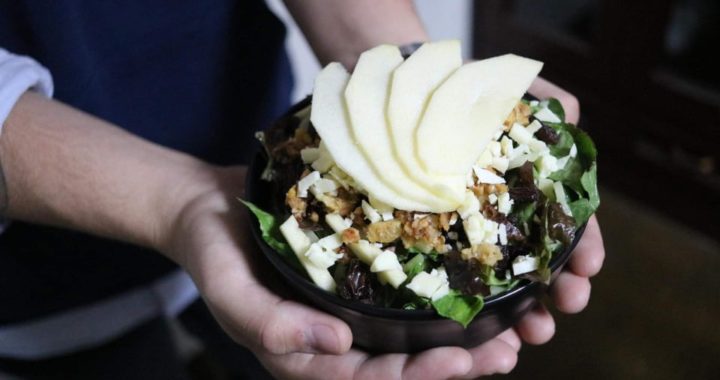Kai’s Kitchen
Roasted Rice and Leafy Greens
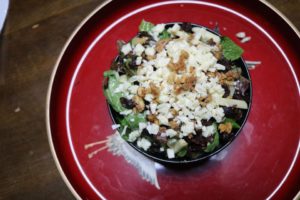
Welcome back all! Welcome back to another mouth watering installment of Kai’s Kitchen! This week we are going to go for something a little lighter and more refreshing. The next dish we have is a palate cleanser, but is still deep and complex in flavor. I present to you a Red Leaf and Romaine salad with a Genmaicha dijon vinaigrette, Japanese pear, pickled daikon, raisins, candy walnuts, and blue cheese! Nutty, sweet, refreshing, zingy; all of these are accented by the tea we are using this week, Genmaicha! The robust dijon paired with the nutty toasted aroma of the Genmaicha makes for a phenomenal addition to the sweetness of the raisins and candied walnuts. But what is Genmaicha?
Genmaicha is a very beloved tea in Japan, and a very easy way to get into Japanese tea because of its flavor being closer to the flavor of tea people are maybe used to. Genmaicha has a lovely roasted aroma due to the toasted rice that is mixed in with the leaves. Toasted rice in tea? You heard that right, brown rice roasted and added to the tea gives it an intense room filling smell; nutty, toasty, and delicious. Here at Obubu Tea Farms, we make our Genmaicha with Genmai (the roasted rice) and Yanagi Bancha (a “lower” grade tea) by mixing the two together at a 1:1 ratio.
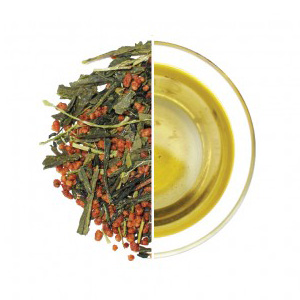
There are tons of stories of how Genmaicha came to be. One story being of a mochi maker not wanting to waste product so he mixed in his mochi that fell to the floor with tea. Another story is that of a samurai’s servant who accidentally dropped some Genmai into his master’s cup from his sleeve after making rice porridge, and was punished swiftly. The one that seems to make the most sense actually comes from a time of poverty and need. The history of Genmaicha is rather simple. When drinking tea started to boom in Japan, (for its delicious taste and health benefits) the price for good quality blends began to become too much for the poorer and working class Japanese. A farmer from Kyoto was looking to sell tea, but the farmers and working class were too poor to buy any of the blends because of them becoming more and more expensive. The farmer then took some roasted rice (as a filler) and his lowest grade tea, mixed them, and sold it so that the working class could buy, drink, and enjoy tea. Thus came Genmaicha, also commonly called “the people’s tea”. The flavor and nutrients were so much so, that it could be drunk when the poor could not afford a meal. Stories from fasting monks drinking it to satisfy their hunger, to soldiers to hurt to eat drinking it to gain important nutrients; Genmaicha is a tea vital to Japan.
Now we know the history, let’s start cooking!
Ingredients
2 heads of red leaf lettuce
1 head of romaine
2 Japanese Pears
10 grams of Genmaicha
1 cup of white wine vinegar
1 ½ cup of oil (canola or olive)
3 tbsp dijon mustard
2 tbsp honey
½ Daikon
1 cup rice vinegar
1 cup of sugar
2 tsp sake
3 cups of chopped walnuts
1 stick of butter
1 cup crumbled blue cheese
Salt and pepper to taste
Recipe
Let’s start with the pickled Daikon. I highly recommend you do this the night before to let the Daikon soak up as much flavor as possible. Heat 1 cup of Rice Vinegar over medium low heat and slowly add the sugar while stirring. Once the sugar has fully dissolved take it off the heat and let cool. While you are waiting for the vinegar to cool, julienne your Daikon. Once the mixture has cooled, move it to bowl and add about 1 tbsp of salt and 2 tbsp of sake to the mixture. Add the Daikon. Make sure the Daikon is fully submerged for a better product. If the Daikon is floating to the top, you can place a small plate on top to fully submerge it into the mixture. Let sit for at least 24 hours.
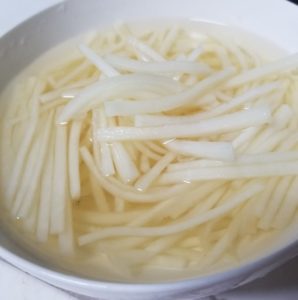
Next we are going to make the Genmaicha Dijon Vinaigrette. Start by heating up the 1 cup of white wine vinegar and Genmaicha tea leaves in a saucepan on medium high heat. When this hits a boil, bring it down quickly to a simmer and cover for a minute. After this, take it off the heat and let steep for another 10 minutes. We are trying to extract as much flavor out of the Genmaicha as possible. In a large stainless steel bowl add 3 tbsp of dijon and 2 tbsp of honey. Once our Genmaicha oil has cooled, strain and squeeze as much vinegar out of the Genmaicha as you can and add the Genmaicha infused vinegar to the bowl. Move all to a mason jar and shake until fully emulsified. Add salt and pepper to taste. Set aside and let sit for at least 4 hour. Shake before serving.

Candy walnut time! Preheat the oven to 350 and chop the walnuts until they are in easy to eat bite sized pieces. We aren’t looking for walnut dust, but also not huge chunks, different sizes are a-ok. Melt 1 ½ sticks of butter and whisk in a cup of sugar. Toss in the chopped walnuts and liberally coat with the butter and sugar mixture and move to a sheet pan lined with parchment paper or tin foil. Sprinkle salt and put in the oven, flipping the nuts and re-salt every few minutes until golden brown. Let sit and break it apart when cooled.
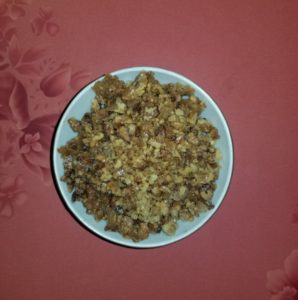
We are close to being done here! Time for the salad to come together. Start by cutting the head of romaine in half. Chop it into bite sized bits and in a bowl, add equal parts red leaf lettuce. Julienne the Japanese pear and add it and the pickled daikon to the bowl. Add your preferred amount of vinaigrette and toss until all ingredients are fully coated. Top with candied walnuts, raisins, and crumbled cheese!
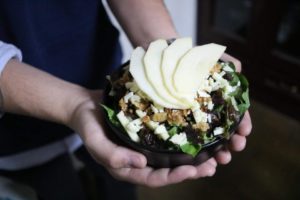
Well friends that’ll do it! This is a favorite for everyone I’ve made it for, and highly enjoyed by another of my senpai Carly De La Cruz. When this post is a few days old she will have returned to Italy to present her thesis she worked long, hard hours on. She really was a great person to talk to and someone who I could always connect with. Whether it be helping each other with recipes, connecting over kitchen lingo, or laughing at obscure Spongebob Squarepants quotes, I speak for all us interns when I say, she will very much be missed. So this ones for you Swarles, and when you get back to Hawaii, eat spam musubi for me!
Kai, Chef, Obubu Intern

